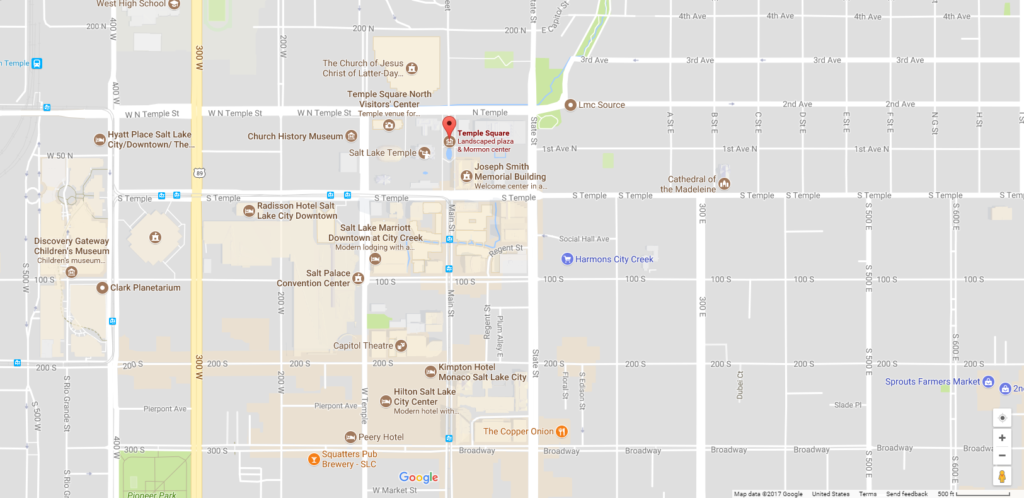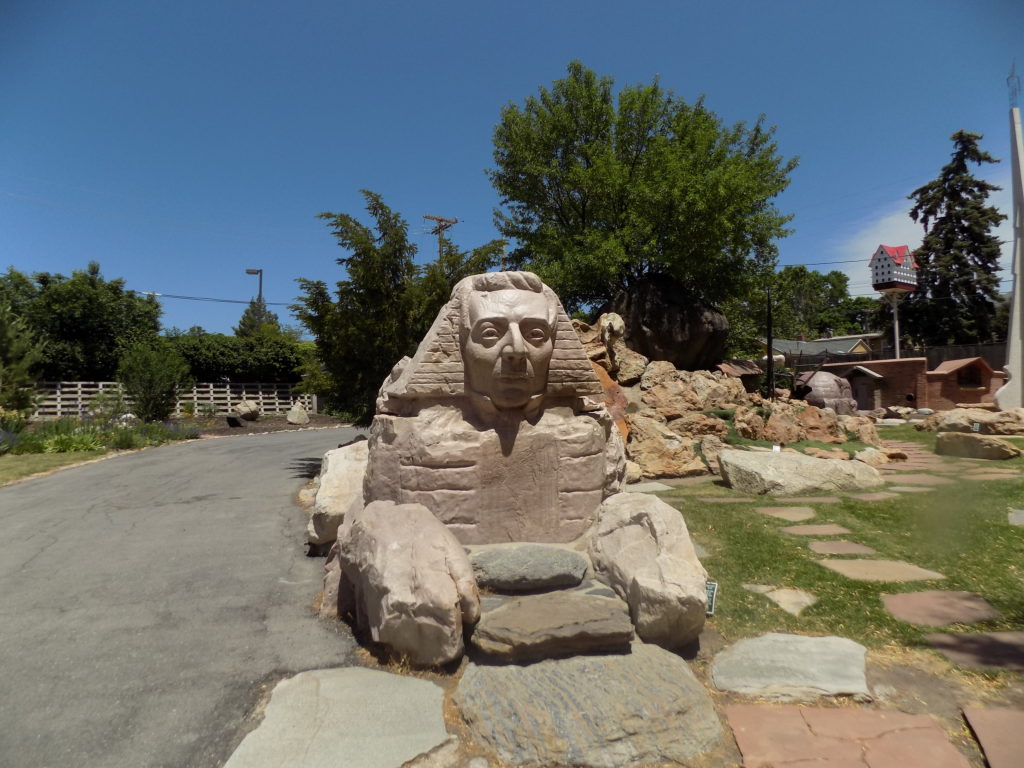At the circle of standing stones
After grabbing a quick fast-food lunch, my next Salt Lake City stop was Gilgal Garden but before I get there, I need to take a brief narrative detour to discuss Salt Lake City’s street names. From my brief time there, I sensed that most of the city’s streets are laid out in a relatively easy to navigate grid pattern. I’d also guess that for longtime residents the street naming and numbering system makes sense. For me, as a visitor in town for a day and a half, not so much.
Here are some inferences I drew from driving in the city:
Most, if not all the streets are numbered regardless of whether they run south to north or west to east. Thus, you can have an intersection where, say, 200 N crosses 200 W so you need to pay close attention to every part of the street name.
For example, the address of Gilgal Garden is 749 East 500 South. This places it between South 700 East and South 800 East. The specificity of “East 500 South” cites your location relative to the southeast corner of Temple Square which is the location of the “Base and Meridian” – the point from which all the city’s streets are named and numbered.
Also, a street can have both a number and a name. Here, the example I’ll use is the address of the Peery Hotel which is listed as 110 Broadway. However, as you can see if you look closely at the screen shot from Google Maps below, Broadway is also 300 South.
So, my advice is that if you’re ever in Salt Lake City, have a good map or a reliable GPS and, above all, pay close attention to the directions included in the street names.
Now we can move on to Gilgal Garden. According to the Jewish Bible, Gilgal is the name of the place where Joshua settled the tribes of Israel when he led them into the “Promised Land” after taking over leadership of that exodus following Moses’ death. There is a neolithic site near Jericho that archaeologists have named Gilgal I. (Gilgal, by the way, translates from Hebrew as “circle of standing stones.”)
The Gilgal Sculpture Garden in Salt Lake City is the creation of Thomas Battersby Child, Jr. who was a Bishop of the 10th LDS Salt Lake Ward. The idea came to him as a way of manifesting his life-long spiritual quest. He began working on his sculpture garden in 1947 when he was 57 years old and that work would consume most of the remainder of his life (he died in 1963) and much of his savings.
Gilgal Sculpture Garden contains 12 original sculptures and over 70 stones engraved with scriptures, poems, and literary texts that, according to Child, each represents an idea that carries spiritual truth. In constructing the garden and opening it for free to the public, he aimed to inspire viewers to ponder “the unsolved mysteries of life” and struggle to find their own answers.
He expected that many people would find Gilgal Garden strange but wanted it to challenge every visitor’s personal vision of spirituality. “You may think I am a nut,” he once said, “but I hope I have aroused your thinking and curiosity.”
One article on Gilgal Garden calls it, “significant as the only identified ‘visionary art environment’ in Utah.”
Dinner and a dino show
Let me start by saying the dinner cited isn’t mine. This day’s not even close to dinnertime yet.
Because that mysterious news item made me decide I needed to be back in Salt Lake City by 18:00 or so, I knew I’d have to skip a few of the sites I’d considered seeing despite their relative proximity to the city. It was early enough that I had time to visit one of them but late enough that if I had to drive too far, I might feel pressed for time.
My decision was affected by the fact that, rather than bringing my detailed list, I’d packed my short list of places to see and everything on the short list was north of Salt Lake. (Had I brought the complete list, I would have probably chosen to go to the Homestead Crater near Park City.) Instead, I headed north to the George S. Eccles Dinosaur Park in Ogden.
With Mount Ogden looming above the city just a few miles to the east of Weber State University, the drive to the park was pleasant and, based on this description of the park from utahoutdooractivities.com,
The George S. Eccles Dinosaur Park is an eight-acre park featuring realistic full-sized dinosaur sculptures enhanced with sound, robotics and artistic details that resemble the real thing. As you enter the park your adventure begins in the Elizabeth Dee Shaw Stewart Museum, which features some of the latest dinosaur finds in Utah and from around the world. The museum includes full-size dinosaur skeletons, real dinosaur bones, teeth, and many other educational exhibits.
I thought this might serve as a reasonable substitute for having skipped the Museum of Ancient Life near Lehi. That will remain an open question.
While I did find some of the exhibits and the fossils displayed in the museum interesting and engaging, my experience in the rest of the park generated less excitement. Admittedly, had I been able to unleash my inner five-year-old, my reaction might have been different.
Although the re-creations are imaginative, fearsome and, perhaps even realistic
and I sense that portraying inactive dinosaurs would make a boring display, I quickly tired of seeing nearly every dinosaur depicted in attack mode – either eating or contemplating their dinner.
I have some pictures here or you can watch the park’s official three-minute video.
I still have a few bits to report about this Friday in Salt Lake City and I’m going to cover them in the coming posts. But, for now, we’ve both earned a bit of rest – I from my writing and your from your reading.
(By the way, I hope you weren’t waiting for me to tie these posts to the hit song by Linda Ronstadt and The Stone Poneys. Other than the odd connections my brain makes, the two are unrelated.)



